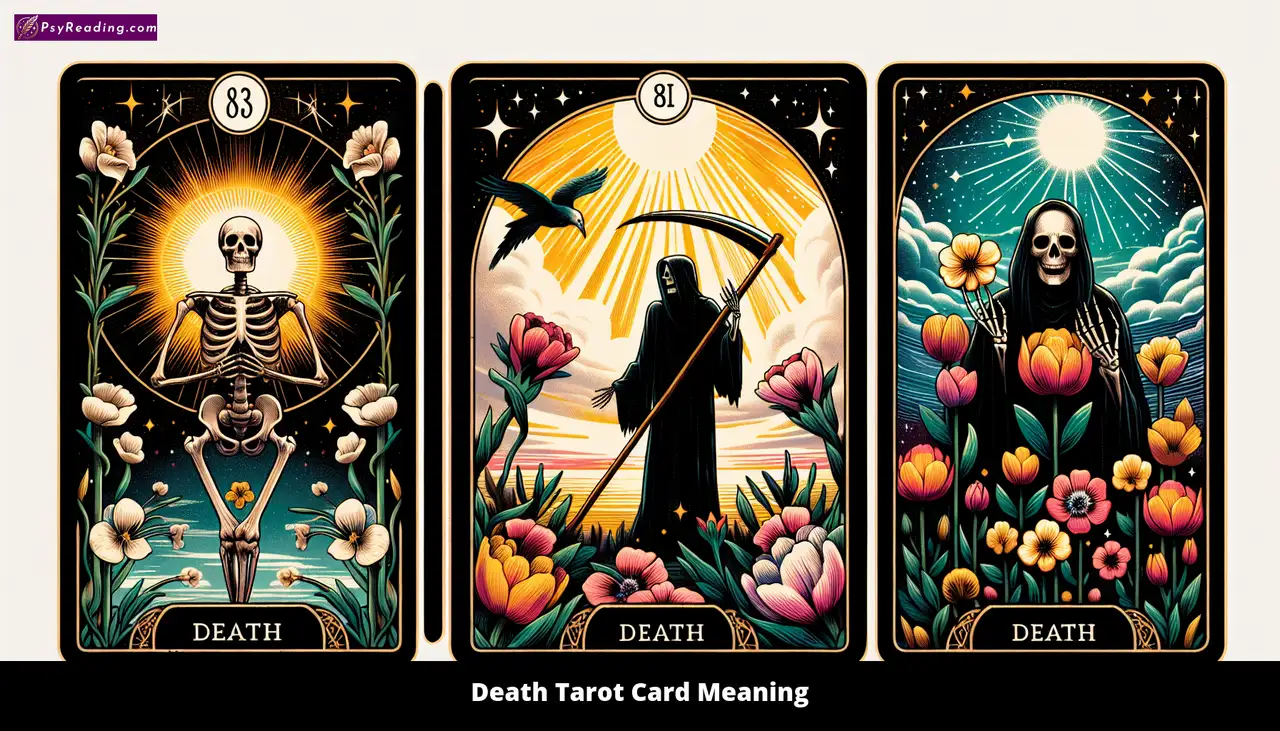The Death Tarot Card is often misunderstood as a symbol of physical death, but it actually represents transformation and change. This article clarifies the true meaning of the Death Tarot Card, offering insight to those who encounter it in their readings.
Appearance of the Death card signifies the end of a cycle and the beginning of a new one. It encourages embracing change, letting go of the old, and welcoming growth and evolution. Whether in love, career, or personal development, the Death card provides profound wisdom about necessary transformations.
Contents
- 1 What Does the Death Tarot Card Represent?
- 2 How is the Death Tarot Card Interpreted in a Reading?
- 3 What is the Symbolism Behind the Death Tarot Card?
- 4 How Does the Death Tarot Card Relate to Personal Growth?
- 5 What is the Impact of the Death Tarot Card on Love and Relationships?
- 6 How is the Death Tarot Card Portrayed in Different Tarot Decks?
- 7 What is the Role of the Death Tarot Card in Career and Finance?
- 8 How Does the Death Tarot Card Affect Emotional and Mental Health?
- 9 What is the Meaning of the Life Tarot Card?
What Does the Death Tarot Card Represent?
The Death Tarot Card represents transformation and the end of a significant phase in your life. It signifies that a major change is imminent, paving the way for new beginnings. This card encourages you to let go of outdated aspects to embrace growth and evolution.
Rather than indicating physical death, the Death card symbolizes the natural cycle of endings and beginnings. It’s a reminder that change is essential for personal development and that embracing it can lead to positive outcomes.
How is the Death Tarot Card Interpreted in a Reading?
In a reading, the Death Tarot Card signifies the conclusion of a major phase and the start of a new one. It advises embracing change and releasing the past to make way for future opportunities.
This card can appear in various contexts, such as relationships, career, or personal growth, indicating significant shifts. It encourages acceptance of what is ending to focus on what is beginning.
What is the Symbolism Behind the Death Tarot Card?
The Death Tarot Card is rich in symbolism, representing transformation and renewal. Common depictions include a skeleton or horse, signifying the relentless nature of change and the cyclical process of life.
The imagery often includes elements like roses or a rising sun, symbolizing hope and new beginnings following the end of a cycle. These symbols reinforce the card’s message of positive transformation.
How Does the Death Tarot Card Relate to Personal Growth?
The Death Tarot Card is a catalyst for personal growth, encouraging you to shed old habits and beliefs that hinder your development. It signifies the necessary endings that lead to new opportunities and self-improvement.
By embracing the changes represented by this card, you open yourself up to personal transformation, fostering resilience and adaptability in the face of life’s challenges.
What is the Impact of the Death Tarot Card on Love and Relationships?
In love and relationships, the Death Tarot Card signifies transformative changes. It may indicate the end of a relationship phase, prompting growth and the potential for new beginnings.
This card encourages letting go of unhealthy patterns or relationships, making space for healthier and more fulfilling connections. It highlights the importance of embracing change for emotional growth.
How is the Death Tarot Card Portrayed in Different Tarot Decks?
The Death Tarot Card varies across different decks but consistently symbolizes transformation. While some decks depict it with skeletons or horses, others use varied imagery to convey change and renewal.
For instance, the Rider-Waite deck shows a skeleton on horseback, whereas the Thoth deck features a dancing figure surrounded by symbols of transformation. Each portrayal reinforces the card’s core meaning.
What is the Role of the Death Tarot Card in Career and Finance?
In career and finance, the Death Tarot Card indicates significant changes or transitions. It may signify the end of a job or a shift in your professional path, leading to new opportunities.
This card encourages reassessing your career goals and financial strategies, letting go of outdated approaches to achieve growth and stability in your professional life.
How Does the Death Tarot Card Affect Emotional and Mental Health?
The Death Tarot Card influences emotional and mental health by prompting introspection and acceptance of change. It signifies the end of emotional cycles, encouraging healing and personal development.
This card can inspire resilience, helping you to navigate emotional transitions and foster a mindset open to growth and renewal.
What is the Meaning of the Life Tarot Card?
The Life Tarot Card, often referred to as the Sun card, symbolizes vitality, enlightenment, and positivity. It represents a time of joy, success, and personal fulfillment. This card is a strong indicator of good fortune and happiness in various aspects of life.
The Life Tarot Card is a beacon of optimism and hope. It signifies a period of growth and abundance. When this card appears in a reading, it often indicates that you are in a phase where you can enjoy the fruits of your hard work and efforts. It’s a time of celebration, achievement, and satisfaction.
However, the Life Tarot Card also encourages you to maintain a positive outlook and to continue striving for your goals. It reminds you that success is a result of your attitude, efforts, and determination. The card is a symbol of the joy and fulfillment that comes from living life to its fullest.
So, when you see the Life Tarot Card in your reading, embrace its positive energy. Let it inspire you to keep moving forward, to keep growing, and to keep celebrating the beauty of life. After all, life is a journey, and the Life Tarot Card is a reminder to enjoy every step of the way.

